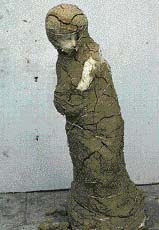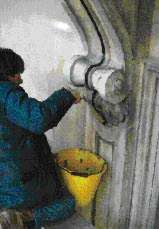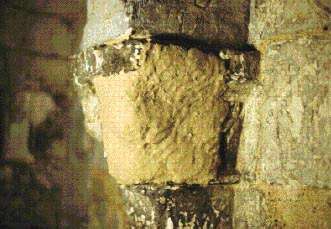Poultices
The true or plain poultice and the cleaning and desalination of historic masonry and sculpture
Catherine Woolfitt and Graham Abrey
 |
||
| Cleaning and desalination of an outdoor marble sculpture using a plain clay poultice |
The
term poultice has its origins in the field of medicine with the application
of a cleansing pack to the body to relieve infection. The notion of
the poultice has been adapted for the cleaning of historic buildings
and a true poultice is intended to draw out deep-seated contaminants
and staining from the surface of masonry and sculpture. In current practice
the word poultice is extended to a wide range of cleaning materials
and techniques, not all of which achieve a true poultice effect on the
substrate.
What might be termed the true or plain poultice contains water and the
poultice medium only, relying on these ingredients to achieve the mobilisation
and removal of the contaminant. The most common poultice medium is clay,
although paper and cotton fibres are also used, and talc, chalk and
even flour are traditional poultice materials. A mixture of clay and
paper fibre produces an absorbent and plastic mixture that is often
favoured by conservators of stone sculpture.
This plain or true poultice is normally used for desalination, to draw
out soluble salts, or as a cleaning method on substrates such as limestone
that respond to water cleaning. In these cases the poultice is allowed
to dry out and the soiling and/or salts are drawn into the poultice
by capillary action with the moisture. Multiple applications may be
necessary to draw the salts from within the surface pores. Whatever
the medium, the poultice is mixed with water to form a material that
will adhere to the substrate. Clay forms a sticky mass that adheres
well to stone and other surfaces. These plain poultices can be conveniently
mixed by hand as required on site with the addition of water to the
poultice medium.
CLEANING PACKS
The plain clay poultice may be modified with the addition of certain compounds to target particular stains or surface coatings. These 'active' or 'chemical' poultices are designed for the removal of the various types of soiling and contaminants that are insoluble in water and for those which have penetrated deep into the surface pores. Proprietary cleaners and strippers are specifically designed and formulated for certain applications, including degreasing surfaces and paint stripping. Poultices containing sequestering agents, such as EDTA, are available for the removal of metallic stains, the copper and iron stains which frequently disfigure masonry subject to rain water run off from bronze sculpture or iron fixings. Sequestering agents chemically isolate specific staining material such as metals, forming compounds which are soluble and can be removed from the surface.
 |
||
| Trial cleaning of a detail on a 19th century cement stucco facade using ammonium carbonate in a clay and paper fibre poultice. |
Alkaline
poultice cleaners and strippers are commonly used for cleaning or degreasing
masonry surfaces and for paint removal. Sodium hydroxide is the most
common alkaline cleaning agent in proprietary cleaners for a range of
masonry substrates, including limestone, sandstone, brick and terracotta
and is the most common ingredient in proprietary paint removers. Care
must be taken in the use of sodium hydroxide based cleaners to minimise
risks to the building and the user. Sodium hydroxide based cleaners
and strippers must be neutralised with acid afterwash. Adjacent, dissimilar
building surfaces must be protected and personal protective equipment
worn by the cleaning operative. In the field of stone conservation ammonium
carbonate is added to clay and clay/paper poultices to remove soiling
from limestone. Ammonium carbonate is a less alkaline cleaner than sodium
hydroxide. It works by reacting with calcium sulphate on the soiled
surface to form calcium carbonate and soluble ammonium sulphate that
can be rinsed off with water.
These 'active' or 'chemical' poultices are all applied to a pre-wetted
surface to minimise penetration of the chemical into the masonry surface
and covered with plastic film to prevent the poultice drying out. The
cleaning additives in these mixtures chemically dissolve the soiling
or staining which is held to the surface of the poultice, and then both
the cleaning agent and the contaminant are removed with the clay. Rinsing
with water and, where necessary neutralisation, follows to remove any
soiling that remains on the surface and also to remove residues of the
chemical cleaners. Strictly speaking these materials are clay-based
cleaning packs rather than true poultices, but the word poultice is
now widely used in the building cleaning industry.
OTHER POULTICES AND GELS
 |
||
| Application of a hot lime poultice to heavily soiled limestone sculpture |
Cleaning agents are often mixed in a gel medium, normally based on CMC (carboxymethyl cellulose). Gels containing alkaline cleaning agents, such as ammonium carbonate, are covered with plastic sheet after application to the surface and in this way function like packs, not true poultices. Other more specialist cleaning packs may be developed for particular cleaning problems on sculpture or decorative masonry detail. One poultice developed for the cleaning of limestone is the hot lime poultice credited to Professor Robert Baker and initially used at Wells Cathedral. Hot slaked lime is highly alkaline and softened the black soiling deposits and the sulphate crust on the limestone. Although successful to some degree this method is difficult to control and non-selective and is now rarely used, even in the field of stone conservation. The Mora Poultice, which contains ammonium and sodium bicarbonate, EDTA and a surfactant in a CMC gel, is still sometimes used for limestone.
DESALINATION
Clay poultices, traditionally of either sepiolite or attapulgite clay, with fine particle sizes in the range of 50mm, have been the usual choice for desalination of historic masonry suffering from soluble salt-related decay. The depth and degree of salt contamination should be understood at the outset of the operation through drilling of masonry to obtain samples at various depths for analysis of the types of salt present and their content. Pre-wetting with sprays must be sufficient for water to reach and mobilise salts in the heart of the masonry, depending on the depth of contamination. The clay will need to be applied with wire mesh or other reinforcement.
Once the poultice has dried out the clay can be removed and a sample must be checked for salt content. This procedure should be repeated until the salt levels are significantly reduced. This procedure can take a long time and periods of months rather than weeks should be anticipated for large-scale and thorough desalination of masonry walls. It should be noted that dry clay powders are potentially hazardous substances and must be used with adequate personal protection, mainly to prevent inhalation of the fine particles.
Desalination
of sculpture and architectural detail on a much smaller scale is used
to draw salts from vulnerable porous surfaces. In certain cases, for
example where the surface has open pores or has badly deteriorated (often
the case with limestone or sandstone sculpture), clay may be inappropriate
and paper or cotton fibres may be preferable and more easily removed. Decisions regarding the cleaning and treatment of sculpture should
rest with an appropriately
qualified and experienced conservator.
CLEANING WITH POULTICES/PACKS
Poultices are normally associated with small scale cleaning but they
are potentially useful for the general cleaning of building facades.
Commercial demands to bring the costs of poultice cleaning in line with
less expensive methods, such as traditional water cleaning, have led
to the development of spray applied poultices. In certain cases clay
based poultices or packs may be the best cleaning option.
Poultices can be used in combination with other cleaning methods. For
example, a sodium hydroxide based poultice might be used to soften and
remove heavy soiling and black 'carbon' deposits on the underside of
cornices and other projecting detail before using a gentle wet abrasive,
or possibly a water cleaning method, to clean the remaining areas of
lighter soiling on the facade. This combination of cleaning methods
on one facade can often provide more control, removing heavy soiling
to decorative mouldings and enrichments with less risk of damage or
over cleaning than using a single cleaning method.
 |
||
| Trial cleaning of a detail on a 19th century cement stucco facade using ammonium carbonate in a clay and paper fibre poultice. |
Poultices can also be used as the principal cleaning method to remove or reduce soiling on a facade. Poultice cleaning is often selected for very detailed facades where more control and care is required in the cleaning procedure. Soiling that has penetrated deep into the masonry substrate is often more easily removed by a poultice than by other cleaning methods. Poultice cleaning can also be used as a post-cleaning treatment to remove areas of staining that may have emerged following the general cleaning of the facade. Plain clay poultices will usually mobilise and remove water soluble staining such as the brownish staining or discoloration sometimes left on Portland and other pale-coloured limestone facades by water cleaning methods.
Incorrect use of chemical poultices can cause damage, for example by the mobilisation of new staining material in the substrate or through inadequate neutralisation or rinsing. Adequate neutralisation or rinsing with clean water to remove potentially damaging residues must follow any chemical cleaning procedure. All poultice materials must be used in accordance with COSHH (Control of Hazardous Substances to Health) and CDM (Construction [Design and Management]) regulations. Many cleaning products and items of cleaning equipment are available to registered or approved users only and material data sheets for all products used must be obtained and consulted.
Site trials are essential prior to any facade cleaning programme to establish which method will be most effective and to indicate the 'level of clean' that can be achieved without risk of damage to the masonry surface. In inexperienced hands any cleaning agent or piece of cleaning equipment can cause damage to surfaces. The cleaning of historic masonry facades should only be carried out by suitably qualified masonry conservation specialists, from the specification stage through site trials and execution of the work.
Recommended Reading
- C Andrew et al, Stonecleaning: A Guide for Practitioners,
The Robert Gordon University and Historic Scotland, 1994
- C Andrew et al, Stone Cleaning in Scotland, 3 volumes with
Research Summary and Literature Review, Historic Scotland and the Robert
Gordon Institute of Technology, 1992
- J Ashurst and F G Dimes, Conservation of Building and Decorative
Stone, 2 volumes, Butterworth-Heinemann, 1990
- N Ashurst, Cleaning Historic Buildings, 2 volumes, Donhead
Publishing, 1994
- MJ Bowley, Desalination of Stone: A Case Study, Building
Research Station, April 1975
- RGM Webster, Stone Cleaning and the Nature, Soiling and Decay
Mechanisms of Stone, Proceedings of the International Conference
held in Edinburgh, UK, 14-16 April 1992, Donhead Publishing, 1992
- C Woolfitt, 'Lime Method Evaluation in English Heritage Research
Transactions', Research and Case Studies in Architectural Conservation,
vol 2, Stone, James and James, London, 2000
- British Standards Institution, BS 8221-1:2000 and BS 8221-2:2000, Code of practice for cleaning and surface repair of buildings; Part 1 Cleaning of natural stones, brick, and terracotta, BSI, London 2000



